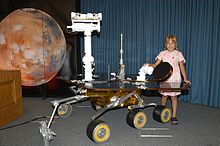IMDb meta-data is 45 minutes of runtime, rated 7.3 by 936 cinemitizens.
Genre: Documentary
Verdict: More, please.
This is an account of the conception, development, production and preparation of Spirit and Opportunity bots to rove Mars. There follows launch, landing, and exploration. Where the cameras cannot go CGI does.
Challenges, there were a few. The rockets bearing the twins — Spirit and Opportunity — travel 12,000 miles per hour to cover the 40 million miles to Mars. But to land the rovers’ speeds have to be reduced to 12 miles per hour or less without damaging anything. ‘We can do this,’ mutter, the tech heads and set to work. This illustration is one of scores of such problems that had to be first identified, then analysed, and finally solved.
The robotic twins were designed to last three months. Yet on and on they have gone like good automatons. Spirit lasted from January 2005 to October 2010. Opportunity is still going! Go girl!
The names resulted from a competition among school children. The girl who submitted these two names was an adopted immigrant child.
 Nine-year old Sofi with one of her namelings. Her 40-word submission says more than the collected tweets of the Twit in Chief, and then some.
Nine-year old Sofi with one of her namelings. Her 40-word submission says more than the collected tweets of the Twit in Chief, and then some.
The assumption was that 90 solar days on Mars would be enough to extract data to prepare for the next mission. These two were rock choppers to gather that data. It was also assumed that after 90 days the ever-present dust on Mars would cover and clog the solar panels powering the rovers. Without battery power overnight, the rovers would freeze and rupture since it falls to -100F overnight. Do not believe the bare chested approach taken in ‘Robinson Crusoe on Mars’ (1967), reviewed elsewhere on this blog.
 Mars.
Mars.
The two rovers were put down on opposite sides of Mars to collect the geological data. They found evidence in worn rocks that there was once water on Mars. And where there was water there may have been life as science knows it.
Spirit broke a wheel and got stuck. All the details are on Wikipedia.
Each rover was handmade and rigorously tested, though no test on Earth equals the real thing on Mars. The unfolding arms were made by hand and tied into place with slipknots. A technician spend days tying the thirty-six knots on each arm, and then testing to see if they would indeed slip. And then doing it again, and again. Yep that is why she went to Cal Tech to do engineering, to tie shoe laces. There were many setbacks and much of the procedure was exhausting, and equally exhilarating.
The whole story is inspiring for even this jaded hack.
Skip to content
